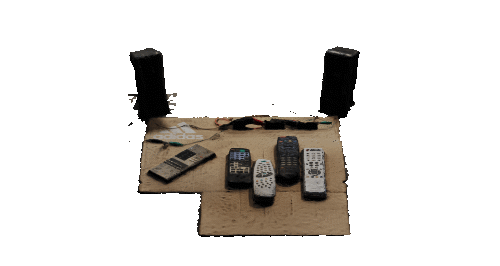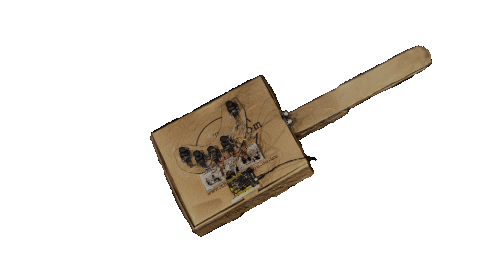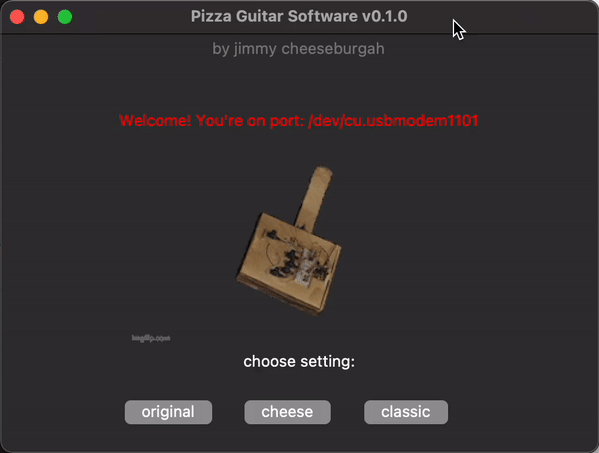


'NEW FRONT' Graduate Project



The final form of this piece is comprised of two physical, self-created and self-designed instruments relying mostly on their electronic mechanisms, including a computer programme written in Python,
and a four-piece composition made with the great help of these instruments, recorded in the format of
a futuristic radio station, approximating the designed sonic subculture to the audience. Therefore, this project takes from areas of music, IT and creative computing, product design, fashion, journalism, and sonic cultures within sociology.


click to launch the online exhibition!
cardboard

bootleg Arduino Leonardo
Python and C++ coding languages
ultrasonic sensor
gamepad analog sticks
used pizza box
jumper wire cables
wooden laundry clips
sellotape
breadboard
white adhesive
drawing pins
iLikeGuitarsGamesAndPizza3005

The idea for this whole project came from a mere will to redesign the concept of a guitar as a versatile, handheld instrument. As a fan of rock music and sound on the whole, I always found it fascinating how influential this instrument can be on the stage presence just by the way it is handled. This aim, combined with another one concerning starting an art collective that will explore and expand the internet’s potential in communication and execution of creativity, inspired me to pursue building a foundation for these major ideas as part of my final year portfolio. As I was exploring the possible aesthetics of DIY, recycled and concept-deconstructing instruments, in addition to the mentioned Arduino-based guitar synthesiser,
I created a second instrument, also a synthesiser, made of secondhand TV remotes and small solar cells placed in a row. Both products are based on used cardboard from delivery packaging, or even a pizza box, that successfully adds to the punk DIY aesthetic of the project.
The guitar’s core is made of 5 gamepad analog sticks, one for each finger of a hand, with each stick controlling a separate oscillator, using values read from its x and y axes. Depending on the setting of interpretation selected at the launch of the coded for it app, values from the axes can control the pitch, tempo or envelope of the oscillators' sounds. Because the way of operating is simultaneously completely new and the field of manipulation of sound provided by the sticks practically limitless, this instrument allows for each user to explore its possibilities on their own, developing various methods of playing.
Oi where are all me telly remotes photoSynthesiser

cardboard
secondhand TV remotes
secondhand computer speakers
solar cells
crocodile cables
white adhesive
drawing pins
By pressing a button of a remote pointed at the row of solar cells, an infrared wave is emitted through the remote’s diode, which at the point of reaching the cell is turned into a current, then turned into sound through the jack pin of the secondhand speakers. Using the remotes' differences in emitted wave frequencies assigned to each button, pressing them in various combinations provides for creative manipulation of obtained sound. In addition, the remotes are placed in their own rails cut underneath them on cardboard, making controlling their distance from the solar cells, thus the volume and intensity of sound, more convenient. Such build references a classic mixing desk fader design.
Since the early stages of this project, one of my main aims was to communicate the limitless possibilities of digital fluency in creativity, by including concepts of a sustainable future and recycling of electronics as an example. What I hadn’t realised until I dived into the process, however, was that my work on this piece could also itself be an art piece, presenting a great image of creative discovery. To keep this exploration pure, I tried not to use any ready coding libraries like PySynth, in what I succeeded by converting mathematical equations into sound. Since the first weeks of my diploma year in Creative Computing at the Creative Computing Institute, when I was getting to know the creative solutions with the use of ready libraries, extensions and applications, I had the ambition to be able to produce work without any such help. I hadn’t anticipated reaching this level before graduating with my bachelor’s degree, so this achievement is something I’m very proud of, especially since it took a lot of time and research to understand many concepts of a programming environment.